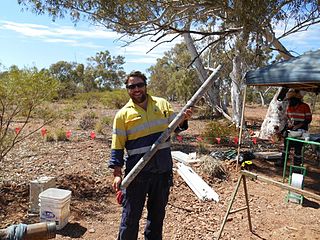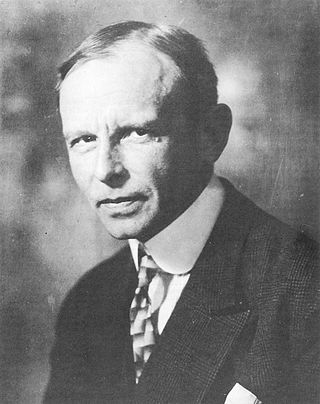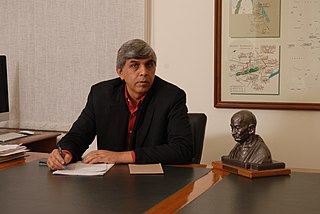Related Research Articles

Geotechnical engineering, also known as geotechnics, is the branch of civil engineering concerned with the engineering behavior of earth materials. It uses the principles of soil mechanics and rock mechanics to solve its engineering problems. It also relies on knowledge of geology, hydrology, geophysics, and other related sciences.

Engineering geology is the application of geology to engineering study for the purpose of assuring that the geological factors regarding the location, design, construction, operation and maintenance of engineering works are recognized and accounted for. Engineering geologists provide geological and geotechnical recommendations, analysis, and design associated with human development and various types of structures. The realm of the engineering geologist is essentially in the area of earth-structure interactions, or investigation of how the earth or earth processes impact human made structures and human activities.

Karl von Terzaghi was an Austrian mechanical engineer, geotechnical engineer, and geologist known as the "father of soil mechanics and geotechnical engineering".

Terzaghi Dam is the key diversion dam in BC Hydro's Bridge River Power Project. It forms the project's largest reservoir, Carpenter Lake west of Lillooet. Originally known as the Mission Dam, it was renamed Terzaghi Dam in 1965 to honor Karl von Terzaghi, the civil engineer who founded the science of soil mechanics. It is located about 30 km up the Bridge River from its confluence with the Fraser.
Ralph Brazelton Peck was a civil engineer specializing in soil mechanics, the author and co-author of popular soil mechanics and foundation engineering text books, and Professor Emeritus of Civil Engineering at the University of Illinois Urbana-Champaign. In 1948, together with Karl von Terzaghi, Peck published the book Soil Mechanics in Engineering Practice, an influential geotechnical engineering text which continues to be regularly cited and is now in a third edition.
Arthur Casagrande was an American civil engineer born in Austria-Hungary who made important contributions to the fields of engineering geology and geotechnical engineering during its infancy. Renowned for his ingenious designs of soil testing apparatus and fundamental research on seepage and soil liquefaction, he is also credited for developing the soil mechanics teaching programme at Harvard University during the early 1930s that has since been modelled in many universities around the world.

Thirumalachari Ramasami is a former Indian Science and Technology Secretary. He assumed charge in May 2006. Prior to this assignment, he served as the Director of the Central Leather Research Institute, Chennai, India. He is a distinguished researcher and leather scientist. He was awarded India's National Civilian Honour the Padma Shri for excellence in Science and Engineering in 2001 and the Padma Bhushan in 2014. He was awarded the Shanti Swarup Bhatnagar Award, the highest award for science in India, for notable and outstanding research in Chemical Sciences in 1993.

Harry Bolton Seed was an educator, scholar, former professor at the University of California, Berkeley. He was regarded as the founding father of geotechnical earthquake engineering.
Dr. Manoj Datta is an Indian engineer specialized in geotechnical engineering, foundation engineering, ground engineering, earth dams, landfill engineering and geoenvironmental engineering. He was the Director of Punjab Engineering College University of Technology and chairperson, Organizing Committee of 6th International Congress on Environmental Geotechnics,. He was also held the office of Dean at Indian Institute of Technology Delhi (2004–2007) and retains his lien as Professor of Civil Engineering at the same institute.

The International Society for Soil Mechanics and Geotechnical Engineering (ISSMGE) is an international professional association, presently based in London, representing engineers, academics and contractors involved in geotechnical engineering. It is a federation of 90 member societies representing 91 countries around the world, which together give it a total of some 21,000 individual members. There are also 43 corporate associates from industry. The current ISSMGE President is Dr Marc Ballouz.
V Ramgopal Rao is an Indian academic serving as the vice chancellor of Birla Institute of Technology and Science, Pilani. He was previously the director of IIT, Delhi for six years during 2016-2021.

Bhagavatula Dattaguru is an Indian engineer and academic. He has received several awards, including the Padma Shri Award, India's fourth highest civilian honour in 2005 in the field of science and engineering.
Gyanendra Nath Pande or Gyan N Pande was a British civil engineer of Indian descent associated with developments in computational engineering. He was Emeritus Professor at the Centre for Civil and Computational Engineering at Swansea University and founder president of the International Centre for Computational Engineering (IC2E).

Professor Dinesh Singh, chancellor K.R. Mangalam University is an Indian professor of mathematics. He served as the 21st Vice-Chancellor of the University of Delhi, is a distinguished fellow of Hackspace at Imperial College London, and has been an adjunct professor of Mathematics at the University of Houston. For his services to the nation he was conferred with the Padma Shri which is the fourth highest civilian award awarded by the Republic of India.

Ganapati Dadasaheb Yadav is an Indian chemical engineer, inventor and academic, known for his research on nanomaterials, gas absorption with chemical reaction and phase transfer catalysis. He served as the vice chancellor of the Institute of Chemical Technology, Mumbai from 2009 until November 2019. He is currently the Emeritus Professor of Eminence at ICT Mumbai.
Ruth Doggett Terzaghi was an American geologist and civil engineer. She held several teaching positions relating to geology and engineering geology. In addition to pursuing her own research, she assisted her husband Karl Von Terzaghi in many of his geotechnical engineering and soil mechanics projects.
Thomas William Lambe was an American geotechnical engineer and an emeritus professor at the Massachusetts Institute of Technology.
Jorge G. Zornberg is Professor and Joe J. King Chair in Engineering in the geotechnical engineering program at the University of Texas at Austin. He has over 35 years' experience in geotechnical and geoenvironmental engineering. He is also one of the pioneers of geosynthetics.

T. G. Sitharam is a civil engineer, professor at IISc Bangalore, former director at IIT Guwahati.Currently, he is serving as Chairman of the All India Council for Technical Education,(AICTE) from 1 December 2022 onwards. He is known for his works in the fields of rock mechanics, rock engineering and geotechnical earthquake engineering. He is an elected fellow of Indian Geotechnical Society, Institution of Engineers (India) and American Society of Civil Engineers.

The International Geosynthetics Society (IGS) is an engineering professional society focused on the field of geosynthetics, which are polymeric materials used in geotechnical engineering. The IGS describes itself as "a learned society dedicated to the scientific and engineering development of geotextiles, geomembranes, related products, and associated technologies." It was founded in Paris in 1983 as the International Geotextile Society and is a member of the Federation of International Geo-Engineering Societies, along with the International Society of Soil Mechanics and Geotechnical Engineering (ISSMGE), International Society for Rock Mechanics and Rock Engineering (ISRM), and International Association for Engineering Geology and the Environment (IAEG).
References
- ↑ "Welcome to Indian Geotechnical Society, New Delhi - INDIA". Archived from the original on 2010-12-21. Retrieved 2011-01-14.
- ↑ "Welcome to Indian Geotechnical Society, New Delhi - INDIA". Archived from the original on 2010-10-31. Retrieved 2011-01-14.
- ↑ "Welcome to Indian Geotechnical Society, New Delhi - INDIA". Archived from the original on 2011-01-16. Retrieved 2011-01-14.